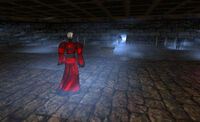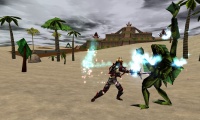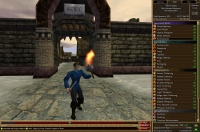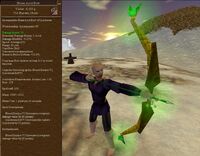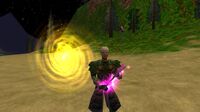- This page largely covers the melee and ranged modes of combat. For more on spell casting, see the Magic article.
Combat is the use of combat skills to defeat Creatures when hunting or completing Quests. It is how you ultimately earn experience and Luminance to improve your Character.
Interface
Peace Mode
Peace mode is the state you're in when the dove button is shown on the interface and you're not in a combat stance. In this mode you can perform secure trades, carry out all crafting actions and heal (trade-off: the switch between the two modes is automatic and faster when healing in combat mode) yourself more successfully; however, your defense will be at its lowest in this mode and you be open to attack and damage. You click the dove to go into combat mode and bring up the corresponding combat panel depending on which type of weapon you're wielding.
Combat Mode
This mode is active when you're wielding a melee weapon such as a Sword or a missile weapon such an Atlatl. The combat bar has a slider for changing the speed versus power when wielding a melee weapon or speed vs accuracy when holding a missile weapon. The high, medium and low buttons refer to the attack height. When you're in combat mode, your defense is at its maximum.

The combat panel while wielding a ranged weapon.
For the magic mode of combat, see: Magic#Magic Mode
Offense
This section covers information on skills and methods to successfully hit the target and inflict damage.
Skills
There are two main classes of offensive combat skills. Primary skills that are used to inflict damage on the target, and secondary combat skills that work with the primary skills to carry out additional maneuvers and improve their damage output.
Primary Combat Skills
- Missile Weapons—Helps you fire missile weapons such as bows, crossbows and thrown weapons.
- Finesse Weapons—Helps you wield finesse style melee weapons.
- Heavy Weapons—Helps you wield heavy one handed melee weapons.
- Light Weapons—Helps you wield light one handed melee weapons. Also helps you punch and kick.
- Two Handed Combat—Helps you wield all two handed weapons.
Secondary Combat Skills
- Dual Wield—Allows you to equip any one handed weapon in your off hand (shield) slot.
- Dirty Fighting—Your melee and missile attacks have a chance to weaken your opponent. High attacks can reduce healing effects on and attack skills of the opponent. Low attacks can reduce the defense skills of the opponent. Medium attacks can cause small amounts of bleeding damage.
- Recklessness—Increases outgoing melee or missile non-critical damage, and incoming non-critical damage from all sources.
- Sneak Attack—Your melee, missile, and magic attacks do more damage from behind. In addition, if you have Deception you have a chance to cause this extra Sneak Attack damage from the front.
Making an Attack
Successfully hitting the target depends on the attacker's abilities being greater than the defender's ability to resist/defend.
Skill Modifiers
Skill modifiers further increase your skill at attacking.
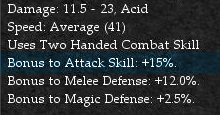 Typical modifiers found on a melee weapon. |
- Melee weapons receive a bonus to attack skill which can be increased permanently with Weapon Tinkering (Velvet Salvage) and temporarily by using the Heart Seeker spell and cantrips, and Black Pages of Salt and Ash.
- Missile weapons receive a bonus to skill through use of the speed/accuracy slider allowing the player to decide whether to attack more quickly at the expense of accuracy, or more accurately at the expense of speed. At the far left of the slider, the attack is fastest but incurs a -40% penalty to the player's attack skill. At the far right, the attack is slowest but gives a +50% bonus to skill.
- Missile characters also incur a penalty to their attack skill for firing at range from approximately 20% at the absolute furthest possible range (75 yards?), down to no penalty at all at about half of outdoor radar range. The weapon's max range is displayed on the weapon's stat panel.
- Magic casters do not currently have offensive skill modifiers.
Damage
Once a successful hit has been made, the resulting damage is a total of various factors.
Damage Modifiers
Character Rating
Main article: Rating
Each character has a rating for outgoing damage including critical hits. Your rating modifiers can be increased through various means including:
- Your character's choice of Weapon Mastery.
- Character Augmentations.
- Equipped Aetheria sigils and with the temporary surges they cast.
- Equipped trinkets imbued with Augmented Damage.
- With the Recklessness skill.
There are also rating modifiers for healing, mana consumption, mana charging and aetheria surging.
 You can view your current damage ratings by assessing your character. |
Melee Weapons
- Melee weapons spawn with a top end damage, and the low end is calculated using the variance (the difference between top end and low end damage). Weapons with high variance and thus higher maximum damages can inflict higher critical hits while weapons with lower tighter variances tend to have better damage over time but weaker critical hits. See Variance for more information.
- Max damage can be improved permanently with Weapon Tinkering (Iron Salvage) and a Gem of Spectral Force, and can be be temporarily boosted with the Blood Drinker spell.
- Weapon variance can be improved permanently with Weapon Tinkering (Granite Salvage) and also by using a Lucky White Rabbit's Foot.
- Melee weapons get a damage modifier through use of the power bar (i.e. a longer power up increases damage) ranging from the lowest setting of 50% to the highest power setting of 150% damage.
- Heavy, two handed and light weapons receive an additional damage bonus from the Strength attribute.
- Finesse weapons receive an additional damage bonus from the Coordination attribute.
Missile Weapons
- Missile weapon base damage is taken from the the ammunition (projectile) and the weapons spawn with a damage modifier and a damage bonus value. The modifier is multipled by the projectile's damage and the damage bonus is then added to get the total damage.
- The damage modifier can be improved permanently with Weapon Tinkering (Mahogany Salvage) and the bonus can be increased temporarily with the Blood Drinker spell.
- Bow and crossbow weapons receive an additional damage bonus from the Coordination attriute.
- Thrown weapons receive an additional damage bonus from the Strength attribute.
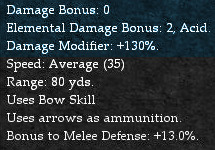 Typical modifiers on an elemental ranged weapon. |
Magic Weapons
- Skill based damage bonus. This additional damage will be a constant percentage of the minimum damage value. The percentage is determined by comparing the level of the spell against the buffed war magic skill of the character.
- Elemental magic casters (e.g. elemental loot casters and rended quest casters) have modifiers which provide a damage bonus to spells which match the caster's element. These bonuses apply to spells used in Player versus Player (PvP) and Player versus Monsters (PvM) combat.
- The elemental damage bonus can be increased by using a Maelstrom of Souls Gem (+1%, 1 use, can be added to fully tinked weapons).
- In addition to the damage and defensive skill modifiers, all Magic Casters can also get a modifier that adds a bonus to Mana Conversion.
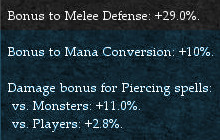 Modifiers on a elemental magic caster (the melee modifier has been increased further through Weapon Tinkering. |
Attack Speed and DPS
In addition to your weapon damage, attack speed also affects your damage per second (DPS) and is a function of your weapon's speed and your character's Quickness attribute. Lower settings on the power/accuracy bar will also increase your speed but at the cost of either power or accuracy depending on your weapon.
Weapon speed can be improved permanently with Weapon Tinkering (Oak Salvage) and temporarily with the Swift Killer spell.
Critical Hits
Critical hits allow you to inflict twice as much damage onto the target for melee and ranged weapons and an additional 50% of the maximum (50% of the minimum for PvP) damage of a magical spell (i.e. 90 of a 110-180 spell). 10% of all melee and ranged attacks and 5% of projectile spells are critical hits. Critical hits can also be inflicted by creatures.
Your critical hit chance can be increased permanently with the Eye of the Remorseless augmentation and by attacking with a weapon that has the Biting Strike or Critical Strike special property.
Your critical damage max can also be increased by attacking with a weapon that has the Crushing Blow or Crippling Blow special property. In addition, your character's Rating for critical damage can be increased to improve damage (see below for more information on character rating and damage modifiers).
| Special property | Function | Notes |
|---|---|---|
| Biting Strike | Increases chance of a critical hit by a fixed rate that varies by weapon. | Quest weapons only |
| Critical Strike | Increases chance of a critical hit by a factor based on the wielder's attack skill. | Tinkering effect (Black Opal Salvage) |
| Crushing Blow | Causes criticals to be multiplied by a fixed rate that varies by weapon. | Quest weapons only |
| Crippling Blow | Causes criticals to be multiplied by a factor based on the wielder's attack skill. | Tinkering effect (Fire Opal Salvage) |
- Critical hit! You impale Olthoi Ripper for 1320 points of piercing damage!
Weaknesses and Slayer Weapons
Many creatures in the game have an innate weakness to one or more types of damage. Sometimes, the weakness can be guessed if the creature is made of a particular element or material as the primary weakness will be the opposing element. For example, a golem made of ice or water will fall quickly to fire attacks and a creature made of fire will be easily defeated with a frost weapon. See each creature page for a list of weaknesses that a creature may have.
The Slayer special property will increase the damage dealt to a specific creature type. Many creature Slayers can be found on quest weapons while some can be added to loot weapons using special gems.
Quest slayer weapons tend to benefit mages more than melee or ranged weapon users. This is because by using the quest weapon, a melee/archer is usually giving up the chance to use armor rend or critical strike and so gains little, whereas the mage gets essentially an additional vuln.
See Category:Slayer for a list of the slayers available.
Life Vulns and Weapon Rending
Life vulnerability spells make the target more vulnerable to specific types of damage or weaken the target's natural armor protection. They can be cast on the target using the Life Magic skill or with Alchemical Throwing Phials using the Alchemy skill. There are also lenses that can be crafted using Item Tinkering which can reduce the target's natural armor protection. The lenses require assess creature skill to use.
Weapon rending is a special property that gives the weapon the ability to make its opponent vulnerable to attacks resulting in a similar effect to that of vuln spells. Loot weapons can be rended by imbuing them with certain types of salvage using the Weapon Tinkering skill or Magic Item Tinkering skill for armor rends. The amount of resulting vulnerability caused depends on the attack skill of the wielder.
There is also a version of this property called Resistance Cleaving that can be found on quest weapons, but resistance cleaving does not scale based on the skill of the wielder and instead has a fixed rate that varies by the weapon.
Weapon effects do not stack with life magic vulnerability spells. A more powerful vuln cast on the target will override the weapon's own effect.
Maneuvers
Charge Attacks
When a player executes a melee attack, they first move towards their target until they are within range to attack. This movement is a charge – it is much faster than the character's normal movement rate, but because of that speed it can only be sustained for a very short distance. If, at the end of the charge, the player is still too far away from their target to attack, they will stop the attack and see the message, "You have charged too far!"
Power Bar Maneuvers
Many weapons can alternate between stabbing and slash motions depending on the power setting. Some one-handed weapons can also deal more than one blow per attack when they have the Multi-Strike property.
| Maneuver | Stance | Power Bar (PB) | PB Damage Modifier |
|---|---|---|---|
| Slash | One-Handed One-Handed (Dual Wield) One-Handed (Shield) |
Full Medium to Full Medium to Full |
150% 100% to 150% 100% to 150% |
| Backhand | One-Handed | Medium | 100% |
| Stab | One-Handed One-Handed (Dual Wield) One-Handed (Shield) |
Low Low to Medium Low to Medium |
50% 50% to 100% 50% to 100% |
| Double Slash | One-Handed One-Handed (Dual Wield) Two-Handed |
Medium to Full Medium to Full Low to Full |
100% to 150% 100% to 150% 50% to 150% |
| Double Stab | One-Handed One-Handed (Dual Wield) One-Handed (Shield) Two-Handed |
Low to Medium Low Low to Full Low to Full |
50% to 100% 50% 50% to 150% 50% to 150% |
| Kick | Unarmed | Full | 150% |
| Punch | Unarmed | Medium | 100% |
| Jab | Unarmed | Low | 50% |
Recklessness
Recklessness allows a player to increase their melee or missile damage at the cost of increase the incoming damage they take. Recklessness does not apply to critical damage numbers. When trained, the combat bar will highlight the area where recklessness is active, which is between 10-90% power. Below or above this range allows the player to attack normally without the recklessness effect. The skill provides a maximum +20 Damage Rating increase if specialized and +10 Damage Rating if trained. This effect decreases proportionally if the Recklessness skill is less than the combat skill.
 How the combat panel appears when Recklessness is trained or specialized. |
Body Zones
Player characters and creatures are divided into various zones, which correspond to specific body parts. For example, the head, chest and upper arms are considered to be in the high zone whilst the lower legs and feet are in the low zone. The medium zone is slightly more complex and can include the chest, abomen, upper arms, lower arms, hands and upper legs. Left and right body parts can be hit individually but is not important as armor levels for the left and right sides are always equal. Once an attack height is chosen, the actual zone that is attacked is a matter of chance with equal probability.
Front and back attacks are also distinct. For example, a creature wielding a shield would be weaker when attacked from behind as shields only protect the front. Rear attacks are very useful if a target is not directly engaged in combat with you. The Sneak Attack skill provides bonuses to rear attacks.
Attack Height and Dirty Fighting
Changing the attack height via the combat panel allows you to direct your attack to a specific part of the target's body. This is can be used to exploit a weakness in the opponent's armor or for attacking a creature that is too high or too low for any other attack height to reach. The attack height is also used by the Dirty Fighting skill to weaken the target.
The Dirty Fighting skill works with missile and melee combat skills by weakening your opponent based on your attack height. The chance for you to land the Dirty Fighting attack is maximized at 25% if your Dirty Fighting skill is equal to or greater than your combat skill. If your Dirty Fighting skill is below your combat skill the chance is decreased proportionally.
- High Attack Height: Target’s Attack skills reduced by 20 if specialized, 10 if trained. Also, the target’s Healing Reduction Rating is increased by 30 if specialized, 15 if trained.
- Medium Attack Height: The target bleeds by 20 damage per tick if specialized, 10 damage per tick if trained.
- Low Attack Height: Target’s Defensive Skills reduced by 20 if specialized, 10 if trained.
All of the Dirty Fighting effects last for 20 seconds once activated.
Sneak Attacks
The Sneak Attack skill gives a bonus to attacks landing from behind the target. This skill works with Melee, Missile and Magic attacks. Specialized Sneak Attack provides a maximum of +20 Damage Rating to attacks from behind and Trained Sneak Attack provides a maximum of +10 Damage Rating. If your Sneak Attack skill is equal to or higher than your attacking skill (War Magic, Missile Weapon, Heavy Weapons, etc.), then you receive the maximum damage. If your Sneak Attack skill is lower than your attacking skill, the effect you gain is reduced proportionally compared to the difference of the skills.
Another benefit of the Sneak Attack skill is that it allows a chance to do an increased attack from the front of the target if the player also has the Deception skill. Trained Deception will allow for a maximum 10% chance to land a Sneak Attack from the front of the target, Specialized has a maximum of 15%. If the Deception skill is 306 or higher, the player receives the maximum benefit. Anything below 306 reduces the chance proportionally.
A player or creature can reduce the damage of a frontal Sneak Attack by having the Assess Person skill. An Assess Person skill of 306 will prevent all frontal Sneak Attack damage. An Assess Person skill below 306 will reduce the damage of a frontal Sneak Attack proportionally.
Stamina Loss
Main article: Stamina
When you attack you lose stamina. The amount of stamina lost depends on a number of factors:
- The weight (burden units) of your weapon.
- The weight (burden units) of your shield.
- The setting on the power bar.
Should your stamina loss become so great that your amount of stamina points reaches zero, the power bar will automatically use the lowest setting.
In addition to using lighter items and a lower power setting, the rate at which you lose stamina can also be reduced by increasing the Endurance attribute (regeneration bonus) when you have a non magic defensive skill trained or specialized.
Defense
Skills
Defensive skills aid in reducing damage received or avoiding it altogether.
- Magic Defense—Helps you resist magic from spells and magic items.
- Melee Defense—Helps you evade melee (hand-to-hand) attacks.
- Missile Defense—Helps you avoid damage in missile (long-ranged) combat.
- Shield—Use the Shield skill to make full use of shields and magic reducing properties of shields.
Avoiding an Attack
Skill Modifiers
Weapons
In addition to the offensive modifiers mentioned above, weapons can also receive bonuses to all three of the main defensive skills.
Melee defense modifiers can be improved permanently with Weapon Tinkering (Brass Salvage) and temporarily with the Heart Seeker spell.
Magic and missile defense modifiers can be improved permanently by using the Missile Defense Weapon Augmentation and Magic Defense Weapon Augmentation (+0.5%, 1 use, cannot use both augs on a weapon).
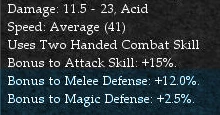 A melee weapon with 2 of the 3 possible modifiers. |
 Defense modifiers on an elemental ranged weapon. |
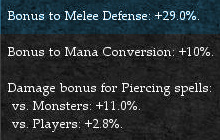 Defense modifiers on an elemental magic caster (the melee modifier has been increased further through Weapon Tinkering |
Counterattacks
If you counterattack at the same height as the target is attacking you will both gain a bonus to melee defense. However, if you counterattack at a different height your defense will be reduced based on the difference in height. A high vs low attack results in a penalty to melee defense and a mid vs low or mid vs high attack results in no penalty.
Damage Resistance
Character Rating
Main article: Rating
There are also ratings for damage resistance and critical damage resistance that can be increased through various means such as your choice of Weapon Mastery and through the use of Augmentations. In addition to resistance ratings, there are rating modifiers for healing, mana consumption, mana charging and aetheria surging.
 You can view your current damage ratings by assessing your character. |
Body Zones and Armor Protection
For lists of armor by coverage, see: Armor
Wearing armor protects your character's body zones (feet, upper/lower legs, abdomen, upper/lower arms, chest and head) from damage and also gives your character endowments if the armor is magical. Successful hits on your character always display the body zone affected during melee combat.
- Tumerok Gladiator grazes your lower arm for 2 points of bludgeoning damage!
Each piece of armor has a base armor level and a modifier for each element that is a percentage of the base AL. For example, if the base AL is 400 and the protection against electric damage is 200 the modifier is 0.5%. When you ID armor, the base level is shown along with the AL for each elemental protection (buffed, not base, if the values are green) and a description that gives the player a quick idea of the amount of protection for each element.
| Armor Modifier | Description |
|---|---|
| 0.0 to 0.39 | Poor |
| 0.4 to .79 | Below Average |
| 0.8 to 1.19 | Average |
| 1.2 to 1.59 | Above Average |
| 1.6 to 1.99 | Excellent |
| 2.0 | Unparalleled |
The base armor level and each individual protection modifier can be permanently improved by using the Armor Tinkering skill. When tinkering the high AL and unenchantable armor types, Covenant Armor and loot Olthoi Armor), you can only improve the elemental protections -- steel salvage cannot be used on these armor types.
A modifier cannot be increased above the cap of 2.0 or double the base armor level.
| Salvage | Description | Max % Success |
|---|---|---|
| Steel Salvage | Increases Armor's Armor Level by +20 | 100% |
| Alabaster Salvage | Increases Armor's Piercing Protection by 0.2 | 100% |
| Armoredillo Hide Salvage | Increases Armor's Acid Protection by 0.4 | 100% |
| Bronze Salvage | Increases Armor's Slashing Protection by 0.2 | 100% |
| Ceramic Salvage | Increases Armor's Fire Protection by 0.4 | 100% |
| Marble Salvage | Increases Armor's Bludgeon Protection by 0.2 | 100% |
| Peridot Salvage | Imbues the target with a +1 bonus to Melee Defense | 38% |
| Reedshark Hide Salvage | Increases Armor's Lightning Protection by 0.4 | 100% |
| Wool Salvage | Increases Armor's Cold Protection by 0.4 | 100% |
| Yellow Topaz Salvage | Imbues the target with a +1 bonus to Missile Defense | 38% |
| Zircon Salvage | Imbues the target with a +1 bonus to Magic Defense | 38% |
AL can also be temporarily improved by using the Impenetrability spell and bane spells:
Shields
Shields protect the wielder in a (roughly) 180 degree arc in front of the character. The use of a shield increases stamina loss during attacks with heavier shields causing a greater amount to be lost. Shields can only actively be used while attacking by melee characters and missile weapon characters that use non-atlatl thrown weapons. Magic, bow and crossbow users all have to unwield their weapon before a shield can be used.
Like body armor, shields have armor levels and protection values for all damage types and elements but do not protect against magic attacks unless they have the magic absorbing special property.
Magic Absorbing
Magic absorbing shields (also known as aegis shields) will negate a portion of all magic projectile attacks. The amount negated depends on the wielder's level of shield skill and also the shield itself (shields vary from 10% to 25% max reductions). Magic absorbing shields generally have much lower AL than standard shields are capable of and the 25% reduction shields are all unenchantable.
Although missile weapon users (except non-atlatl thrown weapons) cannot wield a shield, they can add the magic absorbing property to their atlatl, bow or crossbow using the Fetish of the Dark Idols. The fetish will also reduce the Melee Defense modifier on the missile weapon by 10%. The amount absorbed depends on your base Magic Defense and caps (max) at 25% damage reduction.
For a list of magic absorbing shields and more on the formula for determing magic absorbtion, see magic absorbing.
Life Magic and Natural Resistances
Increasing the attributes, Strength and Endurance (the two are roughly of equivalent importance), allows you to have a level of "natural resistance" to the 7 damage types (bludgeoning, piercing, slashing, acid, fire, cold and electric).
This caps out at 50% resistance (the equivalent to level 5 life protections) to these damage types. This resistance is not additive to life protections: higher level life protections will overwrite these natural resistances, although life vulns will take these natural resistances into account, if the player does not have a higher level life protection cast upon them.
For example, a player will not get a free protective bonus from natural resistances if they have both Prot 7 and Vuln 7 cast upon them. The Prot and Vuln will cancel each other out, and since the Prot has overwritten the natural resistances, there will be no resistance bonus.
Your character's natural resistances, drain resistances, and regeneration rate info is found on the Character Information panel.
Note: Natural resistances are not increased by Strength or Endurance buffs. It is the raw Strength and Endurance scores that determine the bonus.
Stamina Loss
When you're in combat mode (and your defense is at its maximum), you will lose Stamina for every incoming attack that you successfully evade. You do not lose stamina when evading attacks in peace mode; however, you will be more open to attack as your defense is at its lowest when out of combat mode.
The rate at which you lose stamina can be reduced by increasing the Endurance attribute (regeneration bonus) when you have a non magic defensive skill trained or specialized.
Death, Resurrection and Vitae
Main article: Death Penalty
When you die (by misadventure or by being killed by an enemy), you leave behind a corpse containing some of your items and you'll resurrect at the last Lifestone to which you attuned your character. In addition to your dropped items, you will also incur a Vitae Penalty and all your skills will be decreased by the percentage of that penalty along with the maximum values of your secondary attributes -- Health, Stamina, and Mana.
Player Guides
- Aelryinth's Advanced Guide to Combat
- A Void Mage's Guide to Mastering Damage Over Time
- Stillwater's Quick Guide to Playing a Mage
See Also
Images
Click image for full size.


